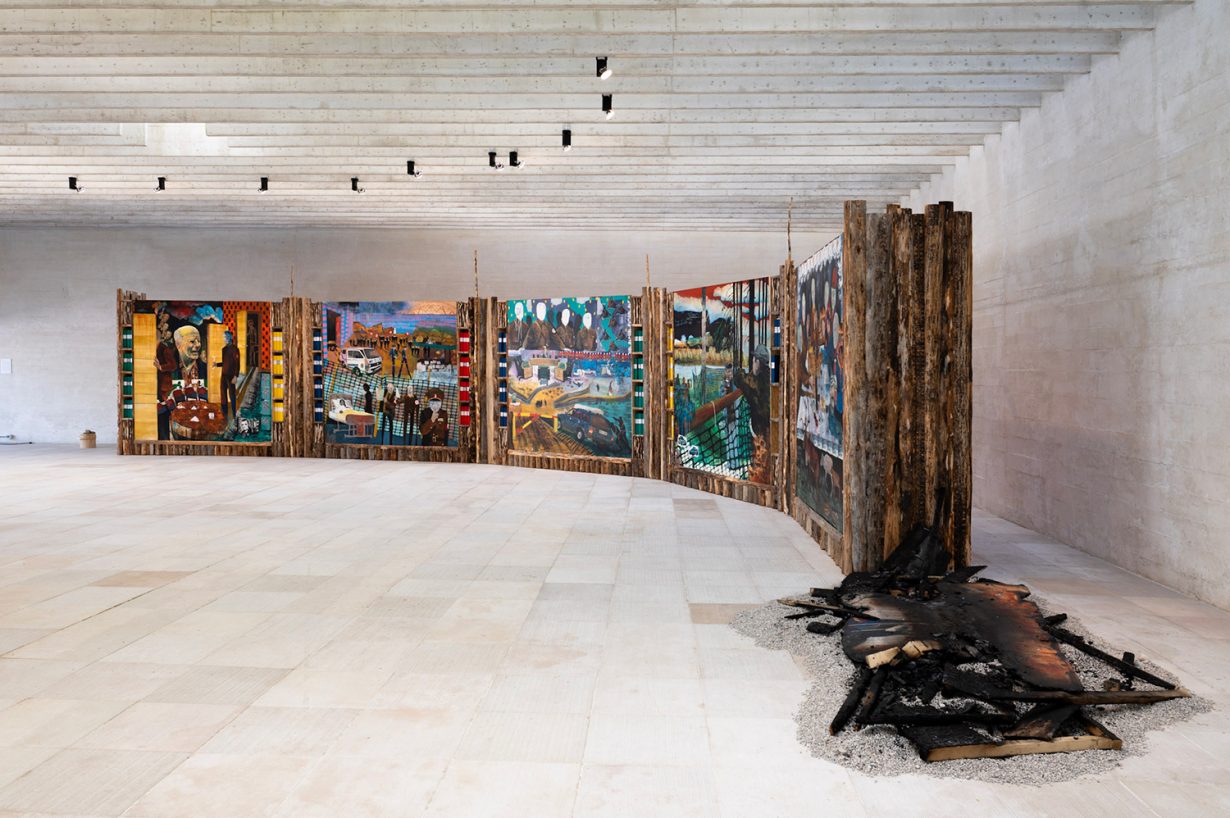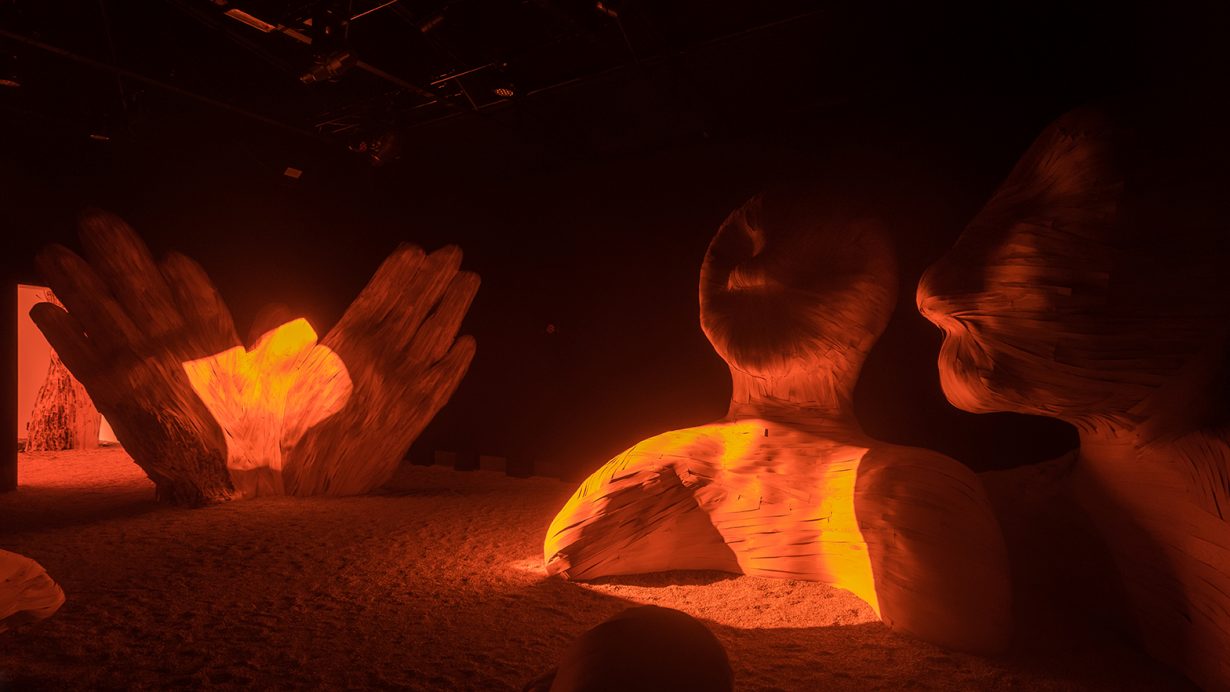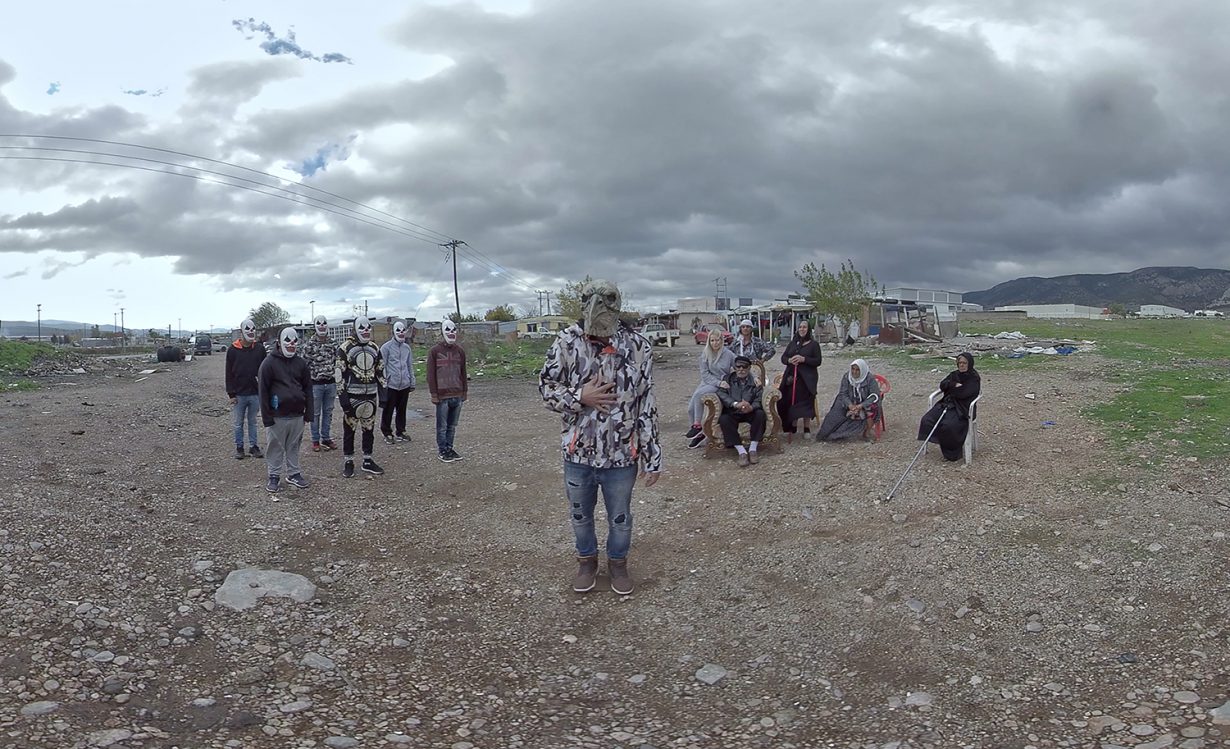The Sámi, Swiss, Finnish and Greek pavilions invite us to reflect on who gets to be included in a community
If the premise of national pavilions – their inherent bid for national art – seems increasingly dated and abstract in an ever-globalised artworld, the shift enacted at the 59th Venice Biennale’s Nordic Pavilion marks a step in a different direction. Finland, Norway, Sweden – the names of the countries traditionally inscribed at the entrance of the pavilion in the Giardini – have been boarded up by a piece of wood to leave room, for the first time, for another cultural geography that challenges its political borders: that of the Sámi people, indigenous to the northern parts of the Nordic countries and the Kola Peninsula in Russia. Featuring works by Pauliina Feodoroff, Máret Ánne Sara and Anders Sunna developed in collaboration with their elders, the Sámi Pavilion speaks to the lifestyles and worldviews of the artists’ communities, which are increasingly threatened by climate change, land dispossession and governmental policies. Feodoroff’s two-channel video installation documents the impact of commercial logging and dams on their habitat and resources, following in one film Sámi river guardians as they move boulders by hand to recreate spawning areas for salmon, which disappeared after the river was dredged.


Similarly oscillating between desolation and hope, Sunna’s and Feodoroff’s works take root in the legal battles many Sámi have faced to maintain the rights to the traditional practice of reindeer-herding. If Sunna’s stunning, freestanding five-panel historic frieze offers nightmarish figurative visions referencing the 50-year legal battle of his family with the Swedish state, Sara’s sculptural installation is a sensorial, poetic celebration of this tradition. The haptic sculptures, made of reindeer stomachs and sinews, hang delicately from the ceiling in fascinating fungilike shapes – tributes to these sensitive creatures which ensure the livelihoods of many Sámi communities and of which nothing is lost or wasted. But what lingers most is their pungent smell, which permeates even the required facemask. The stench has been designed by a collaborator of the artist to express fear – but also hope.

Another sensory experience unfolds at the Swiss Pavilion. Describing her project for the Biennale in a recent interview for ArtReview, French and (who knew?) Swiss artist Latifa Echakhch said she wanted to ‘make a total immersion in what is music… but without sound’. The result is a quiet sensorial journey into a Burning Man-like barren landscape made of gravel and burnt wooden remains, populated by largescale sculptures of colossuses’ heads, hands and legs, that leads us from broad daylight into an increasingly darkened space. In the final room, the disorientating effect of darkness soon turns to a heightened sensory awareness, making us attuned to the crackling sound of our steps and to the bodies (live and sculpted) and spaces that surround us, which intermittently appear and disappear to the rhythm of choreographed lighting. There’s something haunting about the whole experience, a feeling of stepping on some ancient, sacred ceremonial ground that might either offer a metaphor for this storied event or a refuge away from its rituals – depending on how you choose to look at it.

Different kinds of rituals fuel the work of Pilvi Takala. The Finnish artist mostly works undercover. She’s often – and not without humour – infiltrated particular communities and milieus to probe human behaviour and the social norms that shape them, posing for instance as a trainee in the accounting firm Deloitte whose behaviour becomes increasingly strange, or as a wellness consultant in a trendy coworking space. The multichannel video installation Close Watch (2022) developed over two years and presented at the Finnish Pavilion is perhaps her most ambitious anthropological study yet, for which she spent six months working as a guard for a private security firm in one of Finland’s largest shopping centres. Two of the videos document a series of workshops Takala staged with some of her colleagues after finally being outed as an artist, in which hired actors re-enact certain situations she had observed with some disquiet while undercover, inviting the guards to react and step into the scenes to suggest alternative courses of action. The conversations that emerge between Takala and her former colleagues bring up fundamental questions that resonate beyond this particular context: around accountability and hierarchies of power, laced with fears of exclusion, and the kinds of bonding behaviour often performed at the expense of other groups.

From insider to outsider: for the Greek Pavilion, filmmaker Loukia Alavanou has created a virtual-reality film experience which transposes Sophocles’ tragic play Oedipus at Colonus to a Roma community settled outside of Athens, weaving parallels between the fallen king’s exile and this suburban ghetto. Entering the darkened space of the pavilion in which visitors lie in reclining chairs sporting Oculus Rift headsets, it feels like being (voluntarily) drafted into a grim human experiment. This uneasiness continues in the 15-minute docufictional film starring amateurs acting out the drama, narrated by an external chorus, to sometimes grotesque effect. Here Alavanou harnesses the 360-degree possibilities of VR (you can swivel on your chair to look all around you) to blur the line between audience and actors: as the camera moves us through the dusty roads of the shantytown or into a living room, we’re constantly being observed by mask-wearing kids, while the main ‘characters’ stare directly at us. This experience is wildly intrusive and uncomfortable: unable to look away, we’re left to brood over our own position as an intruder or outsider.
